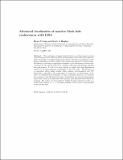Advanced localization of massive black hole coalescences with LISA
Author(s)
Lang, Ryan N.; Hughes, Scott A
Downloadlisa7.pdf (249.7Kb)
PUBLISHER_POLICY
Publisher Policy
Article is made available in accordance with the publisher's policy and may be subject to US copyright law. Please refer to the publisher's site for terms of use.
Alternative title
Advanced localization of massive black hole coalescences with LISA
Terms of use
Metadata
Show full item recordAbstract
The coalescence of massive black holes is one of the primary sources of gravitational waves (GWs) for LISA. Measurements of the GWs can localize the source on the sky to an ellipse with a major axis of a few tens of arcminutes to a few degrees, depending on source redshift, and a minor axis which is 2–4 times smaller. The distance (and thus an approximate redshift) can be determined to better than a per cent for the closest sources we consider, although weak lensing degrades this performance. It will be of great interest to search this three-dimensional 'pixel' for an electromagnetic counterpart to the GW event. The presence of a counterpart allows unique studies which combine electromagnetic and GW information, especially if the counterpart is found prior to final merger of the holes. To understand the feasibility of early counterpart detection, we calculate the evolution of the GW pixel with time. We find that the greatest improvement in pixel size occurs in the final day before merger, when spin precession effects are maximal. The source can be localized to within 10 square degrees as early as a month before merger at z = 1; for higher redshifts, this accuracy is only possible in the last few days.
Date issued
2008-12Department
Massachusetts Institute of Technology. Department of Physics; MIT Kavli Institute for Astrophysics and Space ResearchJournal
Classical and Quantum Gravity
Publisher
Institute of Physics
Citation
Lang, Ryan N., and Scott A. Hughes. “Advanced localization of massive black hole coalescences with LISA.” Classical and Quantum Gravity 26.9 (2009): 094035.
Version: Author's final manuscript
ISSN
0264-9381